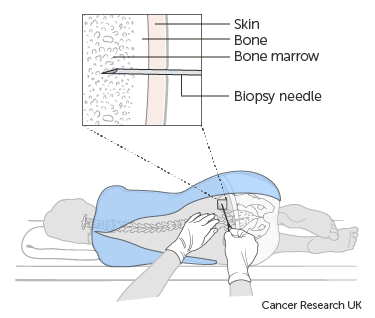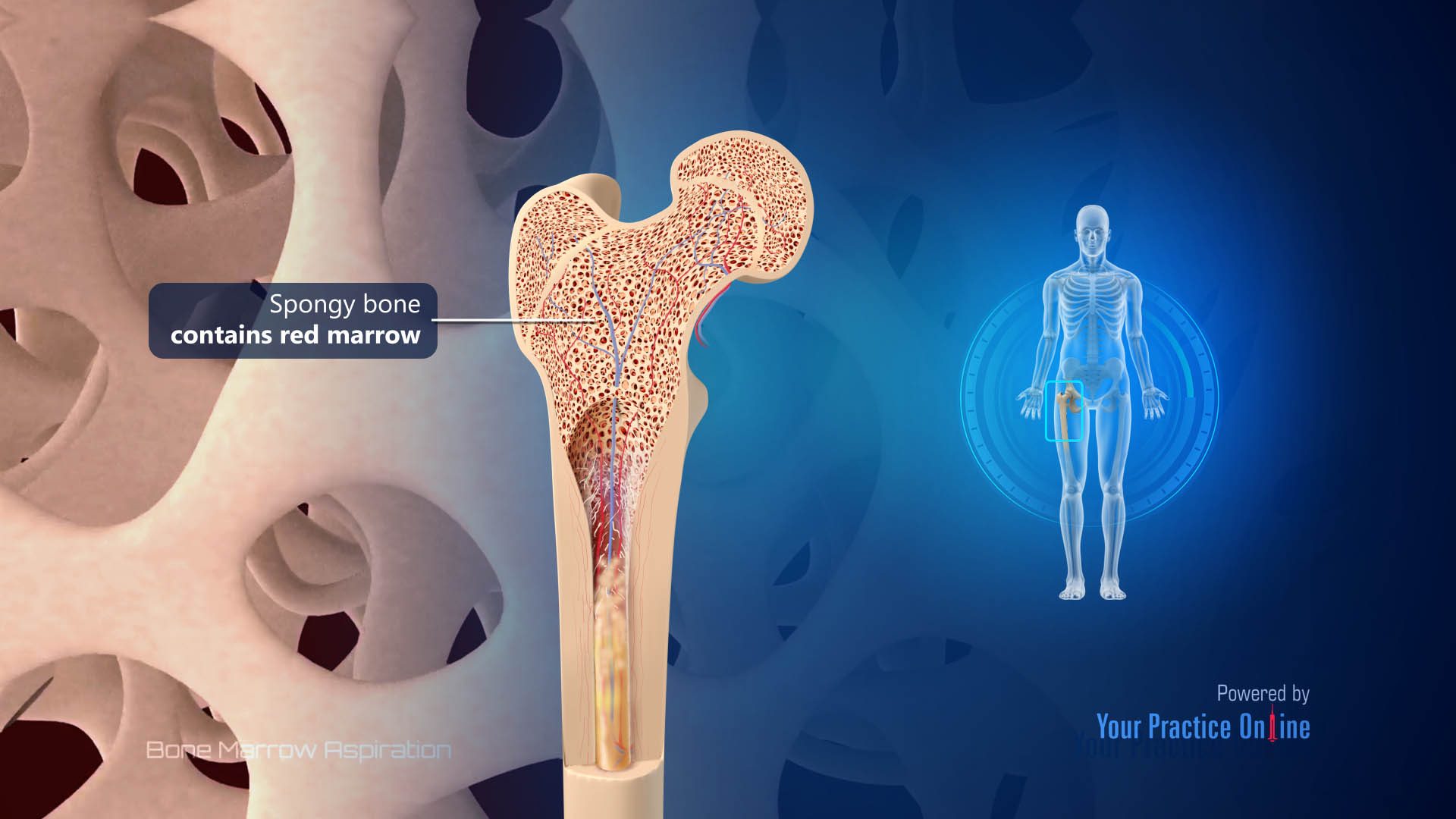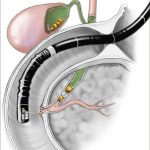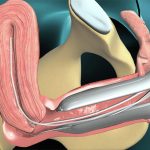What is a bone marrow test?
A bone marrow test is a way of testing cells from your bone marrow. Bone marrow is the spongy tissue inside your bones that makes blood cells.
Why do I need it?
To find out whether there are any cancer cells in the bone marrow. You might also have one to check whether treatment is working.
How do you have it and how long does it take?
You have a local anaesthetic injection to numb a small area on your hip. The doctor puts a needle into your hip to suck out some bone marrow. The test takes about 30 minutes. You should get your results within 1 or 2 weeks.
Are there any side effects?
Possible side effects can include bruising, bleeding, pain, infection or tingling in the legs.
You have a bone marrow test to check whether there are cancer cells in your bone marrow. Bone marrow is spongy tissue and fluid that is inside your bones. It makes your blood cells. Depending on your cancer type, this test can also check how well your treatment is working.
A doctor or specialist nurse removes a sample of bone marrow cells or an area of bone marrow in one piece. This is usually from your hip. A specialist doctor can then look at the cells or tissue under a microscope.

You usually have the test in the outpatient department of the hospital. But you may have this on the ward if you are staying overnight in hospital (inpatient).
You’re usually awake for the test. You have a local anaesthetic  to numb the area. Some people have medicine to make them drowsy (sedation).
to numb the area. Some people have medicine to make them drowsy (sedation).
Why might you have a bone marrow test?
Bone marrow tests are usually done for cancers that are most likely to affect the bone marrow, such as:
- lymphomas
- leukaemia’s
- myeloma
But it can be done for any type of cancer. This is usually if your doctor thinks your bone marrow could contain cancer cells, or they need to rule this out for any reason.
Types of biopsy
There are 2 main types of bone marrow test:
- bone marrow aspiration
- bone marrow trephine biopsy
Aspiration means the doctor or nurse draws some liquid bone marrow up into a syringe.
A bone marrow trephine biopsy means they remove a very thin 1 or 2cm long core of bone marrow in one piece.
You usually have both of these tests done at the same time. They give some of the same information to the doctor, but there are differences. The bone marrow trephine shows the structure of the bone marrow inside the bone, whereas the aspiration takes just the bone marrow cells.
What happens
Your doctor will give you information about the procedure and asks you to sign a consent form. This is a good time to ask any questions you have.
You might need to change into a hospital gown. You can usually keep your underwear on.
You lie on your side with your knees tucked up into your chest.
Your doctor or nurse cleans the area with some antiseptic fluid. This can feel cold.
You’ll then have an injection into the skin over the biopsy site (local anaesthetic) to numb the area. They then put a thin needle through the skin into the hip bone. This might be uncomfortable for some, but this only lasts a short time.
Your doctor or nurse draws a small amount of liquid bone marrow into the needle, using a syringe. You might feel a pulling sensation when they start drawing the bone marrow cells out.
They take this needle out and put the second one in if you are having a trephine biopsy. The aim is to get a small amount of marrow out in one piece.
The whole test takes around 30 minutes.
What to expect when you have a bone marrow test
Your bone marrow is the spongy substance in the centre of the bones where the blood cells are made.
You may have a bone marrow test if you have a cancer which affects the bone marrow such as leukaemia, lymphoma or myeloma. if your doctor thinks your bone marrow may contain cancer cells that have spread from another type of cancer or you have a non-cancerous condition.
There are two types of tests. A bone marrow aspiration which takes some bone marrow cells and a bone marrow biopsy which takes samples of the bone marrow and gives more information about its structure.
Usually your doctor takes the sample from the back of your hip bone but you can have a bone marrow aspiration from your breast bone.
You have the test lying on a couch. You may have a sedative beforehand to make you sleepy. The doctor then injects some local anaesthetic to numb the area.
For a bone marrow aspiration they put a needle through your skin and into your bone. Then using a syringe they draw out some liquid bone marrow. You may feel a pulling sensation as they do this.
For a biopsy your doctor uses a slightly bigger needle to take the sample of bone marrow. They turn and push this needle to get the sample. This can be painful as the needle goes in but it doesn’t last for long.
You usually go home about half an hour after the test. If you had sedation you need to wait until you are fully awake. This can take a few hours.
Afterwards your hip will ache for a few days. Taking painkillers helps.
You may also have some bruising. Rarely you may have some slight bleeding from the site. Press on it if you do and if it doesn’t stop contact the hospital.
There is a small risk of infection. Tell your doctor if you have a temperature or the biopsy area becomes red and sore.
You may have some tingling in your leg which will also wear off with time.
Sedation
Some people prefer to have some type of sedative before the test so that they are a bit drowsy. Some hospitals may use gas and air (Entonox) to help relax you instead of sedation.
Children and teenagers often have sedation for this type of test.
We have a children’s cancer section where you can find out about this test if your child has acute lymphoblastic leukaemia (ALL).
After your bone marrow test
You usually go home the same day if you’re feeling well enough.
You have a dressing over the site, which you should keep on for 24 hours. If you notice any bleeding apply pressure to the area. If it doesn’t stop, contact the hospital.
After the test, your hip might ache for a couple of days. You may need some mild painkillers such as paracetamol to take at home.
As you’re having sedation you’ll need someone with you so they can take you home and stay with you overnight. Also for 24 hours after you shouldn’t drive, drink alcohol, operate heavy machinery or sign any legally binding documents.
Possible risks from having a bone marrow test
A bone marrow test is very safe and any risks are small.
During the procedure there is a very small risk of damage to nearby structures, but this is very rare.
Bleeding
It’s not unusual to have a small amount of bleeding from the area where the needle went in. If you notice any heavy bleeding, apply pressure to the area. If it doesn’t stop, contact the hospital.
Bruising
Sometimes blood leaks out of the vein and collects under your skin. This can look like a small dark swelling under the skin (haematoma). Pressing hard once the needle is removed can help.
Infection
There is a small risk of getting an infection in the wound. Tell your doctor if you have a temperature or if the area becomes red and sore.
Pain
Some people feel uncomfortable and have pain after the local anaesthetic has worn off. Your nurse will tell you what painkillers to take. If you have severe pain or it’s getting worse then you should contact the hospital.
Tingling in your leg
You may have some tingling in your leg which wears off with time.
Getting your results
Your bone marrow test is looked at in the laboratory. The time it takes to receive results depends on the which tests are being done on the bone marrow samples.
Basic results can be available as soon as 24 to 48 hours. Whereas if for example you’re having genetic tests on your bone marrow samples, these results can take a couple of weeks. You won’t get any results at the time of having a bone marrow taken. It’s best to ask your doctor or nurse how long it will take to get them.
Waiting for test results can make you anxious. You might have the contact details of a specialist nurse. You can contact them for information and support if you need to. It may also help to talk to a close friend or relative about how you feel.




